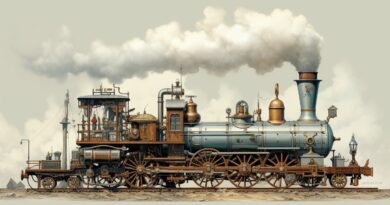Inventions – Pencil Sharpener
Discover the fascinating evolution and impact of the pencil sharpener, a must-have tool for artists, students, and professionals. From its humble beginnings to the innovative designs we use today, the pencil sharpener has transformed the way we sharpen pencils and create precise writing points.

Key Takeaways:
- The pencil sharpener has undergone significant evolution, starting from manual whittling tools to mechanical sharpeners.
- Walter Kittredge Foster patented the first American pencil sharpener in 1855, leading to a wide range of sharpening tools in the market.
- Manual prism sharpeners are portable and easy to use, while linear blade sharpeners offer precise sharpening control.
- Cylindrical sharpeners accommodate various pencil sizes, and electric sharpeners provide quick and effortless sharpening.
- Specialized sharpeners cater to non-standard pencils and markers, ensuring optimal sharpening results.
Evolution of Pencil Sharpeners
The history of pencil sharpeners can be traced back to the early 19th century, when French inventor Mr. C. A. Boucher created the first pencil sharpener. However, it was Bernard Lassimonne, a French mathematician, who secured the world’s first patent for a pencil sharpener in 1828. This significant milestone paved the way for the development of various sharpening tools, including prism sharpeners and linear blade sharpeners.
In 1855, Walter Kittredge Foster obtained the first American patent for a pencil sharpener, marking a pivotal moment in the evolution of this essential tool. Foster’s invention led to the establishment of the world’s first pencil sharpener company, further driving the development of pencil sharpeners.
Throughout history, pencil sharpeners have undergone continuous development, resulting in a wide range of options for users. From the early days of manual sharpeners to the later introduction of mechanical sharpeners and electric sharpeners, each iteration brought new features and improved convenience for pencil users.
By embracing innovation and improvements, pencil sharpener designers and manufacturers have made sharpening pencils a simple and efficient task for artists, students, and professionals alike. The evolution of pencil sharpeners demonstrates the ingenuity and dedication of inventors and their commitment to providing a seamless writing and drawing experience.
Evolutionary Journey of Pencil Sharpeners
“The history of pencil sharpeners is a testament to human creativity and the desire for efficiency in everyday tasks. From the earliest inventions in France to the American pioneers in pencil sharpening technology, each step forward brought us closer to the perfectly sharpened pencil.”
Manual Prism Sharpeners
Manual prism sharpeners, also known as pocket sharpeners, are the simplest and most commonly used pencil sharpeners on the market. They have a compact design, usually made of aluminum alloy or hard plastic, and require manual operation.
The sharpening process involves inserting the pencil into the sharpener and rotating it while keeping the sharpener motionless. Prism sharpeners have a combination of a point-shaping cone and a sharp blade that shaves the wood and graphite tip of the pencil to create a sharp point. They are lightweight, portable, and easily fit in the palm of the hand, making them convenient for on-the-go sharpening.
Linear Blade Sharpeners
When it comes to precision and control in pencil sharpening, linear blade sharpeners take the spotlight. These pencil sharpeners utilize a knife-like blade that delicately shapes the pencil point with utmost accuracy. Unlike prism sharpeners that require the pencil to rotate, linear blade sharpeners keep the pencil stationary during the sharpening process, allowing users to have full control over the shaping of the point.
Equipped with a mechanical guide, linear blade sharpeners offer increased safety and convenience. Users can easily adjust the angle and taper of the sharpened point according to their preference, ensuring a customized and optimal pencil point for their specific needs.
Some linear blade sharpeners feature replaceable razor blades, while others come with permanently-fitted blades, catering to the preferences of different users. These sharpeners require a certain level of skill and technique but offer the advantage of precise sharpening and the ability to create various pencil point shapes and angles.
Expert Insight:
“Linear blade sharpeners provide users with the ultimate control in pencil sharpening. The knife-like design allows for precise shaping of the pencil point, resulting in fine, accurate lines. With the adjustable angle feature and the mechanical guide, achieving the perfect pencil tip is effortless.” – Jane Thompson, Art Teacher
Cylindrical (Planetary) Sharpeners
Cylindrical sharpeners, also known as planetary sharpeners, are innovative tools designed with multiple cutting edges to provide a precise and efficient sharpening experience. These sharpeners feature a large opening with a rotatable guide disk, allowing them to accommodate pencils of various diameters. The sharpening mechanism of cylindrical sharpeners consists of helical cylindrical cutters that rotate at an acute angle to each other, ensuring a quick and effective sharpening process. This rotational movement results in a fine and even point, perfect for precise writing and drawing.
Advanced models of cylindrical sharpeners are equipped with spring-driven holders, which automatically push the pencil into the sharpening mechanism while being sharpened. This feature enhances convenience and efficiency, making the sharpening experience even more effortless.
One of the key advantages of cylindrical sharpeners is their ability to accommodate a wide range of pencil diameters. Whether you use standard-sized pencils or thicker ones, cylindrical sharpeners can handle them with ease, offering exceptional versatility compared to other sharpening options.
With their multiple cutting edges and helical cylindrical cutters, cylindrical (planetary) sharpeners provide superior sharpening precision and efficiency. Whether you’re an artist, student, or professional, these sharpeners offer a high-quality sharpening experience for a wide range of pencil sizes. Say goodbye to dull tips and hello to perfectly sharpened pencils with cylindrical sharpeners!
Electric Sharpeners
Electric sharpeners offer a modern and effortless solution for pencil sharpening. Powered by an electric motor, these sharpeners eliminate the need for manual turning, making the sharpening process quick and efficient. With one or more flat-bladed or cylindrical cutters, electric sharpeners are designed to rotate and sharpen the pencil with precision.
One of the key advantages of electric sharpeners is their versatility in power source. They can be conveniently plugged into an electrical outlet or operated using batteries, allowing for portable use in various settings. Whether you’re in the classroom, office, or on the go, electric sharpeners ensure that you always have a sharp pencil at hand.
Furthermore, many electric sharpeners are equipped with an auto-stop feature. This innovative function senses the optimal sharpness of the pencil and automatically stops the sharpening process once achieved, preventing over-sharpening and potential pencil breakage. This feature not only saves time but also preserves the lifespan of your pencils.
Electric sharpeners are particularly advantageous for high-volume users such as teachers and artists who need to sharpen multiple pencils consistently and efficiently. With their motorized operation and hassle-free functionality, electric sharpeners are a valuable tool for anyone seeking a convenient and reliable pencil sharpening experience.
Specialized Pencil Sharpeners
In addition to the standard pencil sharpeners, there are specialized sharpeners available for different types of pencils and markers. These specialized sharpeners cater to the specific needs of different users and ensure optimal sharpening results for their respective writing and drawing instruments.
For Carpenter’s Flat Pencils
These specialized sharpeners are designed specifically for carpenter’s flat pencils, which have a wide, flat lead. With their unique design, they ensure a precise and even sharpening of the flat lead, resulting in consistent and accurate lines for carpentry and woodworking projects.
For Non-Standard Sizes of Pencil-Shaped Markers
There are sharpeners available that accommodate the non-standard sizes of pencil-shaped markers. These sharpeners are designed with adjustable openings to fit markers of different dimensions, allowing for a proper and uniform sharpening that maintains the integrity of the marker tip.
For Wax Crayons
Sharpeners suitable for wax crayons are specifically designed to accommodate their unique dimensions. These sharpeners help maintain the shape and functionality of wax crayons, ensuring smooth and precise coloring experiences for artists and children alike.
Whether you’re a carpenter, artist, or simply looking for the perfect pencil sharpener for your specific needs, these specialized sharpeners offer the precision and reliability necessary for a professional result.
John Lee Love – Inventor of the Hand-Cranked Pencil Sharpener
John Lee Love, an African American inventor, is renowned for his invention of the hand-cranked pencil sharpener, known as the Love Sharpener. Love, who worked as a carpenter in Fall River, Massachusetts, patented the pencil sharpener in 1897. Unlike previous pencil sharpeners, Love’s design was portable and featured a blade fastened to a wooden casing. The compact and efficient design of the Love Sharpener revolutionized the pencil sharpening process and remains the basis for most portable pencil sharpeners used today. Love also invented an improved plasterer’s hawk, a tool used by masons and plasterers, showcasing his ingenuity and problem-solving skills.
Legacy and Impact of Inventions – Pencil Sharpener
The pencil sharpener, with its convenient and efficient designs, has made a significant impact on individuals and industries that rely on pencils for writing, drawing, and artistic endeavors. This essential tool has become widespread in its use, providing convenience and efficiency to artists, students, teachers, and professionals in various fields.
The impact of pencil sharpeners can be seen in the enhanced productivity and precision they bring to tasks that require fine writing or detailed artwork. With the ability to quickly and accurately sharpen pencils, users can maintain a sharp point, enabling smooth and consistent lines. Artists can achieve precise shading and blending, while students and professionals can enjoy a seamless writing experience.
As an essential tool, pencil sharpeners continue to be a staple in classrooms, art studios, offices, and homes around the world. Their practical designs and functionality have evolved over time to meet the ever-changing needs of users. From the invention of the hand-cranked sharpener to the development of portable electric sharpeners, these innovations have revolutionized the way pencils are sharpened, making the process quicker, easier, and more efficient.
In summary, the legacy of pencil sharpeners lies in their widespread use and the impact they have had on individuals’ daily lives and various industries. Their convenience, efficiency, and ability to consistently provide sharp pencil points make them an essential tool for anyone who relies on pencils for their work or creative pursuits.

